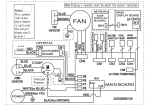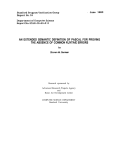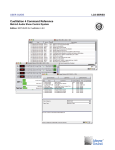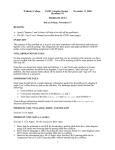Download USER'S GUIDE TO CLTC Didier CHAUVEAU
Transcript
USER’S GUIDE TO CLTC A Software for MCMC Convergence Diagnostic using the Central Limit Theorem for Markov chains www.univ-orleans.fr/mapmo/membres/chauveau/pgm/cltc/cltc.html Note: This program is available freely for non-commercial use only Version 7.5 (2002) Didier CHAUVEAU Universit´e d’Orl´eans, France [email protected] Contents 1 Introduction 3 1.1 MCMC methods . . . . . . . . . . . . . . . . . . . . . . . . . . . 4 1.2 MCMC convergence assessment . . . . . . . . . . . . . . . . . . . 4 1.3 Methodology behind the CLTC software . . . . . . . . . . . . . . 5 1.4 Overview of the CLTC software . . . . . . . . . . . . . . . . . . . 5 1.4.1 Method 1: Running CLTC using observations stored in a file (preferable) . . . . . . . . . . . . . . . . . . . . . . . . 7 1.4.2 Method 2: Plugging the MCMC code into CLTC . . . . . 8 1.4.3 CLTC output and output files . . . . . . . . . . . . . . . . 8 2 Running CLTC 9 2.1 The CLTC distribution . . . . . . . . . . . . . . . . . . . . . . . 9 2.2 Preparing for Method 1: control after the simulation . . . . . . . 10 2.2.1 . . . . . . . . . . 12 Preparing for Method 2: simulation and control in the same program . . . . . . . . . . . . . . . . . . . . . . . . . . . . . . . . . . 12 2.3.1 Including the MCMC algorithm . . . . . . . . . . . . . . . 13 2.4 Compiling . . . . . . . . . . . . . . . . . . . . . . . . . . . . . . . 14 2.5 Input files and CLTC tuning parameters . . . . . . . . . . . . . . 15 2.5.1 The discrete case . . . . . . . . . . . . . . . . . . . . . . . 16 Launch CLTC . . . . . . . . . . . . . . . . . . . . . . . . . . . . . 16 2.3 2.6 Using the “single to parallel” converter 1 2 CONTENTS 2.7 2.8 Program output . . . . . . . . . . . . . . . . . . . . . . . . . . . . 17 2.7.1 The C program output log . . . . . . . . . . . . . . . . . 17 2.7.2 The CLTC output file . . . . . . . . . . . . . . . . . . . . . 19 2.7.3 The Mathematica output . . . . . . . . . . . . . . . . . . 20 Interacting with the program . . . . . . . . . . . . . . . . . . . . 21 Chapter 1 Introduction This document is a user’s guide for a software called “CLTC” (an acronym for Control via the Central Limit Theorem), which implements the methodology described in Chauveau and Diebolt [4]. The objective of this software is Monte Carlo Markov Chains (MCMC) convergence assessment. Note that this software will not help you to design and implement an MCMC algorithm for your particular application. The convergence diagnostic is a calculation that is typically performed after or along with the simulations. CLTC provides you with a generic, “black-box” type software tool for the convergence diagnostic of your MCMC algorithm. It can be used to perform the convergence diagnostic simultaneously with the simulations, or as a second step after the simulations (provided that you ran a sufficiently large number of iterations from your MCMC sampler and that you stored these observations in a file). This guide is intended to help potential users to run this software. Its goal is therefore not to explain what are MCMC algorithms, and what is the convergence assessment problem. References for the theoretical background are given at the end of the document. Good introduction to MCMC methods are [7] or [10], and only the very basics are recalled briefly below. For the same reason, the methodology behind the CLTC software is not entirely described here. Users are strongly encouraged to take a look at Chauveau and Diebolt [4], or alternatively to check the companion preprint [2] that is included in the distribution (as the postscript file CLTCtechreport.ps). This toolbox is available online and can be sent to interested users upon request to [email protected]. Other explanations and downloads can eventually be found on the web URL: www.univ-orleans.fr/mapmo/membres/chauveau/pgm/cltc/cltc.html This program is available freely, but is for non-commercial use only. 3 4 CHAPTER 1. INTRODUCTION 1.1 MCMC methods In short, a MCMC method is a way to define a Markov chain (θt )t≥0 with some given probability distribution π as its stationary distribution. This target distribution usually comes as the posterior π(θ|x) for the parameter θ is some Bayesian setup given the data x. Hence π is known only up to a multiplicative constant, and i.i.d. sampling R from π or inference that requires computation of expectations like Eπ (h) = h(θ)π(θ) dθ are not directly available. We assume that h is real-valued to simplify the presentation given here. The Markov chains produced by MCMC methods are ergodic under mild conditions, so that the Strong Law of Large Numbers (SLLN) holds. This allows the approximation of Eπ (h) by the empirical average n 1X h(θt ). n t=1 (1.1) The Central Limit Theorem (CLT) for Markov chains holds if there exists a limiting variance 1 (1.2) σ 2 (h) = lim var [Sn (h)] , n→∞ n satisfying 0 < σ 2 (h) < +∞, and such that 1 d ¯ → √ Sn (h) N 0, σ 2 (h) , n where Sn (h) = n X t=1 h(θt ) ¯ = and Sn (h) n X t=1 (1.3) [h(θt ) − Eπ (h)] . Conditions for the CLT to apply are given, e.g., in Meyn and Tweedie [9]. When the CLT holds, the precision of the approximation (1.1) can be computed, or confidence intervals can be proposed. Producing such confidence intervals for parameter estimates is one of the by-products of the CLTC software. 1.2 MCMC convergence assessment The conditions under which the Markov chains produced by MCMC methods are ergodic are necessary, but however insufficient for the implementation, since they suffer from a significant problem in actual application: how to determine the moment when we can conclude their convergence, in other words, when one should stop the chain and use the observations in order to estimate the distribution characteristics considering that the sample is sufficiently representative of the stationary distribution. This is the so-called convergence assessment problem. More details about convergence assessment, together with a survey of the literature on the subject can be found in Brooks and Roberts [1]. An important criterion for convergence assessment methods is the required computer investment: diagnosis requiring problem-specific computer codes for 5 CHAPTER 1. INTRODUCTION their implementation (e.g., requiring knowledge of the transition kernel of the Markov chain) are far less usable for the end user than diagnosis solely based upon the output of the sampler, since the latter can use available generic code. The CLTC software is completely generic, since it is based only on the realisations from parallel chains, and it works without knowledge on the sampler driving the chain. In addition, the normality diagnosis leads to automated stopping rules. This is the reason why it has been implemented in a software available online. 1.3 Methodology behind the CLTC software The methodology described in [4] or [2] is grounded on the fact that approximate normality of appropriate functions of the chain is an indication of sufficient mixing. The diagnostic is based on the time needed to reach approximate nor√ mality for normalized sums of functions of the Markov chain like Sn (hr )/ n, for a collection of real-valued functions hr , r = 1, 2, . . . related to the posterior distribution or the parameters of interest. This convergence time is obtained by CLTC through statistical tests and variance monitoring performed over time and based on the realisations from independent parallel (i.i.d.) chains, i.e. m simulated i.i.d. copies of the chain: θ(ℓ) , ℓ = 1, . . . , m, where (ℓ) θ(ℓ) = θt , t = 1, . . . , n is the ℓ-th chain. The first control tool tests the normality hypothesis on the basis of the i.i.d. samples of these normalized averages computed over the i.i.d. chains. A second connected tool is based on graphical monitoring of the stabilization of the associated limiting variance. A first set of functions h’s consist in indicator functions hr = IAr of subsets Ar of the support of the target π. This gives convergence diagnostic, approximate normality and confidence intervals for the histogram (the picture) of π. A second set consists in moment functions like (in dimension one) h(θ) = θp , p = 1, 2, . . .. This gives convergence diagnostic and confidence intervals for the parameter moments, e.g., for means and variances. As stated previously, CLTC can run the parallel simulation for you and compute the convergence time during the simulation (for that you just have to define your MCMC sampler within the source code and compile the whole thing). Alternatively, you can run your own program for your MCMC sampler, store the realisations from i.i.d. chains in a plain text file, and run a generic version of CLTC using this file as an input file. These two methods are decribed in the next section. 1.4 Overview of the CLTC software Theoretically, the methodology used by CLTC can be applied to any Markov chain in any general state space. However, the convergence diagnostic of the histogram of π (i.e. over the indicator functions of subsets of the state space) CHAPTER 1. INTRODUCTION 6 is hard to implement as dimension increases. For simplicity and ease of implementation, we have thus restricted the generic CLTC implementation to control one-dimensional functions of the original chain. Functions of Markov chains are not Markov chains, but should satisfy the CLT if the original chain does, and hence are still testable for sufficient mixing using CLTC. The method then consists in diagnosing convergence for each marginal of the original chain, and eventually for any suitable one-dimensional function (e.g. any recoding of interest) of the original chain ψ(θt ) , t ≥ 0, for ψ(·) ∈ R. The fact that all the marginals satisfy the normality convergence criterion computed by CLTC does not mean that the multivariate original chain satisfies the criterion after the same number of iterations. This is a trade-off between simplicity/ease of implementation and precision or conservative rule. Advantages and drawbacks of this approach are discussed in [4]. The main features of the program are: • convergence diagnostic for both discrete and continuous Markov chains; • automated control diagnostics, based on simple tuning parameters; • “black box” tool, completely independent from the MCMC algorithm to control; • does not require technical/analytical knowledge of the kernel driving the chain; • standard ANSI C generic code for the essential part of the software (from parallel simulations to diagnostic); • additional (optional) features available in a Mathematica NoteBook document, delivering graphics for visual control and more diagnostics based on asymptotic variance stabilization. The drawback of this methodology is the computing time: CLTC needs simulation of m parallel (i.i.d.) chains, even if this is not required by the application. Note that for technical reasons m must be 30 or 50 in this implementation. Since the control method is generic, the “core” source code of the program should not be edited or modified by the user. However, the CLTC black box needs to be “linked” in some way to the output from the MCMC algorithm which needs a convergence diagnostic. This may be done in two ways: CHAPTER 1. INTRODUCTION 1.4.1 7 Method 1: Running CLTC using observations stored in a file (preferable) The first way of using CLTC is by writing simulation output from your MCMC algorithm in a plain text file (in a simple format that will be specified in § 2.2), and by “telling” CLTC where the file is at runtime. Since the method is using parallel chains, CLTC needs an “array” of simulated values, i.e. the m i.i.d. chains running for n iterations. Fortunately, you don’t really need to write a parallel version of your MCMC sampler. It is often simpler to run your “single chain” program m times and to store the n iterations of each run in a corresponding plain text file. It is then easy to write a little piece of code to bring together these m single chain files into one “parallel chains file” suitable for input to CLTC. A generic program for doing this (file single2parallel.c) is already included in the distribution and is discussed in § 2.2.1. The only important thing is that (ℓ) the m initial parameter values θ0 must be drawn randomly from a dispersed distribution over the support of π. That is, the m chains should not start from the same initial position. Advantages of using Method 1 are that: 1. it is the easiest way when the MCMC algorithm is not originally implemented in ANSI C or C++; 2. the CLTC source files need not to be edited at all: a ready-to-use set of source files (folder CLTC_generic_Method1) for one-dimensional realisations (function or marginal of the original Markov chain) is already included in the distribution; an already compiled application is included in the Macintosh version; 3. the computing time necessary to run CLTC_1D_generic itself when the simulations are already done and available in file is very small (less than 1 mn for m = 50 chains of n = 10, 000 iterations each, on an average PowerMac G3). This allows to quickly check several settings for the tuning parameters on the same simulations output (see § 2.5 and [2] or [4]); 4. if the MCMC is complex (time consuming simulation, high dimension) you can just run the m simulations once, and write the output of all the marginals (and/or any suitable functions ψ(θ)) in separate files during the simulation; then you have to run CLTC_1D_generic over each “parallel chains file” (one for each marginal), but these steps are not CPU demanding (see point 3). 5. if, when running CLTC_1D_generic over the file containing the n iterations for the m chains of your sampler, convergence is not reached, you can (ℓ) run more iterations for the m chains with θn as the starting value for chain ℓ, and append these more iterations to the original file. Then re-run CLTC_1D_generic and so on, up to convergence. CHAPTER 1. INTRODUCTION 1.4.2 8 Method 2: Plugging the MCMC code into CLTC The original idea behind the implementation of CLTC was that, since the user needs in any way to write the piece of code implementing the MCMC method for its particular application, it is convenient to plug this piece of code into another generic piece of code that will do the necessary simulation and the convergence diagnostic simultaneously, and will call the MCMC sampler when appropriate. This gives another way of using CLTC. Advantages of this approach are that: 1. the user needs only to implement a C procedure, performing one step of the MCMC sampler1 , to adjust some external variables, and to compile this code together with the C package given in the distribution (the code is already prepared for this). 2. the user needs not to implement the parallel simulation; these are done automatically at runtime by CLTC. A drawback of this approach is that CLTC needs to be run for each marginal, since it controls one marginal at a time. If the MCMC is complex (i.e. CPU time-consuming), or in high dimension, it is generally preferable to use the first method. 1.4.3 CLTC output and output files The CLTC software consists in two parts: a program in ANSI C for the heavy simulation and convergence diagnostic task, and a Mathematica NoteBook2 document for some user-friendly and interactive output, graphics monitoring convergence and improved convergence diagnostic that needs some matrices inversion (see § 2.4 and [4]). The Mathematica processing in not required; you may just use the C program if you just don’t need graphics and improved convergence tool, or if you cannot run Mathematica on your system. The C program gives an output in the window where it has been launched (UNIX) or in the window it opens when launched (MacOS). This ouput gives the result of the convergence diagnostic and some useful information about the controlled region, its mass, the controlled mass, etc. . . (see § 2.7, and [2] or [4] for a complete description). The C program also writes an output file which is actually a Mathematica document that can be processed with the NoteBook CLTC_public_7.5.nb included in the distribution to deliver graphics, etc. . . (see § 2.7 and information on the NoteBook itself). 1 typically called MCMC(current theta,next theta), where the input argument is the current value, and the output the next value of the multivariate parameter 2 Mathematica 3 or higher is preferable; check http://www.wolfram.com Chapter 2 Running CLTC 2.1 The CLTC distribution CLTC is available for both UNIX and Macintosh platforms. Actually, it can be used on Wintel platforms also since it only consists in C sources and Mathematica NoteBooks that are plain text files. You only need a C compiler and a running Mathematica system. The distribution consists in several C files, some plain text sample input and output files, two Mathematica Notebook files, and the companion preprint and this document as PostScript files. The Macintosh version also includes two already compiled executables: CLTC_1D_generic for the generic version (i.e. using Method 1), and another one implementing a sample version of CLTC using Method 2, for a simple Gibbs sampler that has been used in [3]. Executable files are not provided for the UNIX version since the compiled code depends on the platform (SUN, HP workstations, PC running LINUX, etc. . . ). Finally, the distribution also includes a folder containing the source file of the converter from m single chain files to one parallel chains file, together with a toy-example to show how it works (see § 2.2.1). The folder CLTC_C_FILES_Method2 holds the core C files of CLTC appropriate if Method 2 is used. Most of these files should not been edited. Two “MCMCspecific” files that have to be edited by the user to define its MCMC sampler are in the same folder. The editable files given with the distribution provide an example implementing a Gibbs sampler for a multinomial benchmark example described in [3]. 9 10 CHAPTER 2. RUNNING CLTC Folder CLTC_C_FILES_Method2: GCLT 7.5.c GlobalDecl.c InOut.c MticaIntf.c Simulation.c McmcDecl.c McmcAlgo.c the main file for the current version global declarations for the whole CLTC system handling reading from and writing to files handling output interface to Mathematica contains the core functions of the program MCMC-specific declarations (editable) MCMC sampler definitions (editable) The folder CLTC_generic_Method1 holds a similar set of files for the generic version of CLTC, appropriate if Method 1 is used (i.e. convergence diagnostic based on simulated values from the MCMC sampler stored in a file) . These files should not be edited. An already compiled version, CLTC_1D_generic, is included on the Macintosh distribution for the current version. Input and output sample files: infile sample outfile sample simulation tuning parameters (example) GCLT 7.5 program output for this example Mathematica Notebook files: CLTC public 7.5.nb Sample output.nb Notebook for Mathematica 4 Notebook giving a sample output Executable files (Macintosh distribution only): CLTC 1D generic 7.5 CLTC 7.5 single2parallel generic version for Method 1 (version 7.5) sample version for Method 2 converter from single to parallel chains PostScript files: CLTCtechreport.ps CLTCguide.ps the companion preprint [2] this user’s guide Folder single2parallel_Converter: single2parallel.c single2parallel x.1 x.2 x.3 x.parallel 2.2 source file of the single to parallel chain converter executable file (Macintosh only) sample file, iterations for chain number 1 sample file, iterations for chain number 2 sample file, iterations for chain number 3 parallel chains file generated by the converter Preparing for Method 1: control after the simulation If you use Method 1 and you control one (or several) one-dimensional function of the Markov chain, then you don’t have to edit any of the CLTC source files. 11 CHAPTER 2. RUNNING CLTC Under the Macintosh distribution you don’t even have to compile anything. Let us assume that you want to control a set of K functions of the original chain, ψk (θ) for k = 1, 2, . . . , K. In most situations K is the dimension of the parameter space and ψk is the k-th coordinate, i.e. θt = (θt,1 , . . . , θt,K ) ∈ RK , and ψk (θt ) = θt,k ∈ R. For a single chain implementation which is ran m times (the simplest method), the necessary steps are: 1. Implement your MCMC algorithm in the language of your choice (if your MCMC is not CPU-demanding, you can even use high-level languages such as MATLAB, SciLab,. . . ) 2. Implement instructions within your MCMC simulation program to write the one-dim functions ψk (θ)’s to plain text output files. A typical set of C instructions for that and for the k-th function is FILE *fopen(); /* declaration */ char fname_k[30]; /* declaration for the k-th output file name */ FILE *Outfile_k; /* declaration of pointer to k-th output file */ Outfile_k = fopen(fname_k,"w"); /* opening file in writing mode */ for (t=1; t <= n; t++) /* loop over time */ { your instructions for simulation here... fprintf(Outfile_k,"%f\n",psi_k(theta)); /*output current value*/ } where psi_k(theta) is your implementation of your function ψk (θ), and theta is the current value of the multivariate parameter, θt . 3. Run your MCMC sampler m times: You have to control K functions ψk (·), k = 1, . . . , K of the original chain, but all the files should be generated simultaneously i.e. during these m runs (to save computing time). This means that each single run ℓ simulates the n iterations of the ℓ-th chain, and writes K output files, the k-th file containing the n iterations of (ℓ) the function ψk (θt ), t = 1, . . . , n. Following this procedure, you should end up with m × K files. Initial distribution: It is important to start these m chains from (ℓ) different, uniformly distributed initial positions θ0 . The good thing is to directly simulate the initial value within your MCMC program from a distribution “as dispersed and uniform as possible”. See the example provided in the distribution for Method 2, which generates the initial values from the uniform distribution over the support defined by the user. Make sure also that your random generator is not giving you the same initial position for the m chains, as it can be the case if you use m times the same seed for the pseudo-random generator. 4. Generate K “parallel chains” files, where the k-th file contains the m × n values of ψk (θ) over the m i.i.d. chains. The format of this file 12 CHAPTER 2. RUNNING CLTC must be: (1) ψk (θ1 ) (1) ψk (θ2 ) .. . (1) ψk (θn ) (2) ψk (θ1 ) · · · (2) ψk (θ2 ) · · · .. .. . . (2) ψk (θn ) · · · (m) ψk (θ1 ) (m) ψk (θ2 ) .. . (m) ψk (θn ) i.e, the t-th row must contains the m observations at time t of the function ψk of the m i.i.d. chains, for t = 1, . . . , n. The numerical values are expected by CLTC to be in standard floating point notation, as given, e.g., in C by the fprintf instruction similar to the one given above, using the format descriptor "%f " (giving 6 significant digits by default). Values in each lines are separated by a simple space character. The file single2parallel.c provides a C program for generating a “parallel chain” file from m single chain files (see below). 2.2.1 Using the “single to parallel” converter The folder Single2Parallel_Converter contains the source file single2parallel.c (and a Macintosh application single2parallel in the Macintosh distribution) to perform step 4 above. This program will build a “parallel chains file” from m single chain files for you if your files follow the standard format given above (in step 2). Each of your single chain files must contain the n iterations of the one-dimensional function of the markov chain, one observation per line, in standard floating point notation (e.g., using "%f\n" in C). The folder holds a set of m = 3 single chain files of n = 10 iterations each, and the corresponding “parallel chains file”, to provide an example of how it works. To use it, just compile the source file, launch the application, and answer the questions (“root name” for the input files, output files etc. . . ). Note that single2parallel works in a very simple way: it first successively opens the m single chain files, and load the observations into RAM. Then it writes out these m × n observations “in parallel” in the output file. This means that a large amount of RAM is necessary to process long sequences. For example, the compiled version given in the distribution can process m = 50 chains for up to n = 20, 000 iterations. Since each value is coded as double precision (8 bytes), it requires about 8 Mo of RAM. If you need more than 20, 000 iterations, simply increase the size of MAXIT in the source file and recompile it. 2.3 Preparing for Method 2: simulation and control in the same program For Method 2 described in § 1.4.2, you need to write the procedures needed to run your MCMC sampler in a text source file that will be compiled with the CLTC source files. This is done through the steps below. 13 CHAPTER 2. RUNNING CLTC 2.3.1 Including the MCMC algorithm 1. Make a copy of the sample files McmcDecl.c and McmcAlgo.c from the folder CLTC_C_FILES_Method2 since you will have to edit the original ones. 2. Edit the file McmcDecl.c: this file contains the MCMC-specific declarations, typically giving the parameter dimension for array declaration, and some cosmetic information like definition of names for parameter coordinates (which is what) and a name for your MCMC algorithm. These are not mandatory, they are just used for output. Below is an example of the editable lines in this file: #define MAX_P_DIM 3 int param_dim = 2; /* dimension for arrays declaration for */ /* the parameter, = param_dim + 1 */ /* parameter dimension, model-specific */ /* enter below MCMC title and names for your coordinates */ char MCMCdef[] = "Gibbs sampler for the Multinomial benchmark."; char *Coordname[] = {"","mu", "eta"}; Here the MCMC sampler is two-dimensional, with θ = (µ, η), so that the dimension of arrays must be 3 (due to the way arrays are defined in C, with the first item at coordinate [0], which is not used in CLTC, so that θj is stored in theta[j]). For the same reason, the names of the coordinates begin with an empty string "". The other declarations in the file should not be edited. 3. Open McmcAlgo.c in a text editor and write in ANSI C the implementation of one step of your MCMC algorithm. The main procedure must be called MCMC(current_theta,next_theta), since it is called with this name in the CLTC source files. The arguments are the current and next values of the multivariate parameter θ. Their names inside the procedure can be anything (e.g., theta and update as below), but their declaration must be like this: void MCMC(theta,update) double theta[MAX_P_DIM]; double update[MAX_P_DIM]; { your instructions here... } /* current parameter value */ /* updated value */ In other words, if θt is the current position of a Markov chain associated to the parameter, then the “algorithm” theta ← θt MCMC(theta,update); should return update = θt+1 . Of course, this procedure can call other functions and procedures as needed; just put all these in the same text file McmcAlgo.c as for the example supplied. This step is the only one requiring some programming skill from the user. However, it should be straightforward, since the user is supposed to already have a program CHAPTER 2. RUNNING CLTC 14 source for the sampler he whishes to control. The file must contains its own declarations (random generator, parameters, procedure for reading observed data from a text file if the model needs data (e.g., in Bayesien setup, etc...). See the example provided as a template file in the distribution1 . 4. Edit the procedure DrawInitTheta(theta) in the same file McmcAlgo.c. Its purpose is to generate the initial positions randomly over the support defined by the user. See the example provided in the file for the 2-dim case. 5. In some rare situations, you may have to edit the file Simulation.c (in this case make a copy first). A call to your sampler, MCMC(current_theta,next_theta); is already included in the proper place in this file, and you usually don’t even have to open this file. However, some particular MCMC algorithms may require some more specific instructions inside the main simulation loop to handle special situations. If it is the case, these instructions should take place in the main loop. You can locate the proper place in the file by searching for the comment *BEGIN OF USER MODIFICATION SECTION* to find where. See more instructions in the file. CAUTION: do not make any change above or below the section in the file dedicated for user modification!!! 2.4 Compiling After editing appropriate files, and whatever the method you choose, you have to compile the whole thing with a standard ANSI C compiler. You just have to compile the main program file GCLT 7.5.c that will include all the other files itself: • On a UNIX workstation you may use, e.g., the gnu compiler gcc with the -lm option for math library. The typical command to generate an executable file called CLTC is: gcc -lm -o CLTC GCLT_7.5.c • On a Mac, existing compilers are Absoft C/C++, CodeWarrior distribution, MPW (Macintosh Programmer’s Workshop). . . , both for 68K or PowerPC chips under MacOS 9 or older versions. Under MacOS X, a C compiler is included since it is a UNIX-based operating system (I did not check native versions of CLTC under MacOS X yet, but current version works under Classic). Here, you need to compile GCLT 7.5.c only if you are using Method 2. • On a Wintel box, get a C compiler and do as for UNIX. 1 The very good random generator KISS from Marsaglia and Zaman [8] is included and used in the sample file McmcAlgo.c. It is strongly recommended to use it for the simulations. CHAPTER 2. RUNNING CLTC 2.5 15 Input files and CLTC tuning parameters Due to the need for the code to be compatible across a number of platforms, the input/parameters to the program are not specified through a graphical user interface, but via a simple text-mode which consists in: 1. defining the CLTC tuning parameters in the “input file”, a text file with a specified format given below; 2. answering sequential questions at the beginning of the program, to tell CLTC the name of the input file, the data file (if any), the “parallel chains file” (if Method 1 is used), and the output file (for Mathematica postprocessing). Here is a sample input file for setting the control tuning parameters of CLTC: mu0 StopRule dtz_chain ccoord nmax nstep fstcs nmc ncs prob_tresh Support 2 1 1 1 10000 100 50 50 17 0.0001 0.8 3.5 The meaning of the parameters in the input file are: initial distribution, 1=dirac, 2=uniform over the support (2 should always be used, 1 was merely for testing) StopRule stopping rule for convergence, 1 = TM , 2 = simultaneous (see [2]) (1 is less conservative and preferable) dtz chain 1 = request computation and output of the matrices for the discretized chain; 0 = not requested (see [2] and comment below) ccoord coordinate (marginal of θ) to control (needed for Method 2) should always be 1 for Method 1 nmax total number n of iterations to run (Method 2) or read from the parallel chains file (Method 1) nstep number of iterations between each control stage fstcs iteration number of an additional first control stage (< nstep) nmc number m of parallel markov chains ncs number of sets p in the partition of the support (see [2]) prob tresh probability treshold parameter ε (see [2]) Support controlled region A for the marginal (see [2]) mu0 CHAPTER 2. RUNNING CLTC 16 Tuning parameters important for the methodology: To fully understand the meaning of the tuning parameters (A, p, ε) that are crucial for the methodology, it if strongly recommended to read [2], § 4.1, where these are described in details. The mathematical notations that appear here are also defined in the reference papers. The parameter dtz chain also deserves more explanation: For a discrete, finite chain, it is possible to compute algebraically an estimate of the limiting variance of an indicator function of a singleton Ii , where i is a point in the state space. This computation requires inversion of the estimated transition matrix of the chain, and is done in the Mathematica part of CLTC using matrices written in the CLTC output file. This computation helps to check stabilization of the estimate of the variance, by comparing it to the estimates of the variance after n steps, always provided by CLTC. Hence for a finite chain, it is a good idea to set dtz chain = 1. For a continuous (general) chain, however, CLTC provides an approximation of the chain via a discrete “pseudo-chain” defined over the sets Ar , r = 1, . . . , p, and an approximation of the limiting variance by inverting the approximated transition matrices against control times (see [2]). It should be pointed out that this approximation is not theoretically valid, and in addition, if p = ncs is large, it requires in CLTC a large amount of extra material that has to be written in the output file, and processed by Mathematica. Hence for large p (e.g. p > 100), it is preferable to set dtz chain = 0. Note also that in this implementation, you specify with nmax the total number of iterations available in the parallel chains file (Method 1), or you select a maximum value nmax for the number of iterations to simulate (Method 2). If convergence is not achieved after nmax using Method 2, than you have to give a larger value for nmax and re-run the whole thing, which can be tedious if your MCMC is computationaly intensive. In this case, it is better to use Method 1, as suggested in § 1.4.1, point (5), since it is always possible to append more iterations to your single chain files, and to re-run CLTC, up to convergence. 2.5.1 The discrete case In the discrete case, i.e. when each marginal θk ∈ N, it is preferable to define the support A and the sharpness p so that each set corresponds precisely to a single, or a set of integers. For example, if θ ∈ {0, 1, . . . , 10}, a good setting can be A = [−0.5, 10.5] with p = 11, so that each set Ar is of the form [r − 1/2; r + 1/2], r = 0, . . . , 10. 2.6 Launch CLTC When CLTC comes up, it displays some information, and then asks few selfexplicit questions. Below is an example using the CLTC_1D_generic version (Method 1): 17 CHAPTER 2. RUNNING CLTC MCMC CLT CONTROL FOR GENERAL MARKOV CHAINS c D. Chauveau, 12/2001. C pgm Version 7.5 - Generic: 1-dim MCMC sampler (or recoding) with obs from file Enter file name for input parameters : in.a.17 Enter file name for Mathematica output : a.out Enter output type (1=long, 0=short) : 0 Parallel chains file name : alpha Note that the output type is a trigger between “short output type”, which just displays summary information and is usually preferable, and “long output type” which displays much more computations in details, and is merely for debugging. 2.7 2.7.1 Program output The C program output log The log is what appears in the main CLTC window. You can redirect it to a file, or save it manually, but it is not saved automatically by CLTC in a file. After the questions above, CLTC prints the tuning parameters that have been read in from the input file: MCMC CLT CONTROL FOR GENERAL MARKOV CHAINS c D. Chauveau, 12/2001. C pgm Version 7.5 - 1-dim MCMC sampler (or recoding) with obs from file (output file suitable for Mathematica processing). SIMULATION PARAMETERS : initial distribution method: mu0 actual maximum nb of iterations: nmaxint nb of iterations between each control: nstep nb of control steps: nbpts nb of iterations before first control: fstcs nb of parallels MC to be run: nmc nb of sets in partition: ncs control probability treshold: prob_tresh Support definition Set size Stopping rule for convergence ccoord=1 Controlled coordinate is x computations related to discretized chains = = = = = = = = = = = 2 10000 100 101 50 50 17 0.000100 (0.800000 , 3.500000) 0.158824 Max{CLT times} = requested Then, the parallel simulations are performed (Method 2), or read in from the “parallel chains file” (Method 1) together with the convergence diagnostic calculations, and results are displayed in the simulation log in a synthetic way. The “short output type” (selected at the beginning of the program) is preferable 18 CHAPTER 2. RUNNING CLTC for ordinary users. The short output gives information about the status of the sets Ar , i.e. of the partition of the support with respect to the approximate normality, against the control stages. The control stages have been defined by the user in the intput file, by the parameters fstcs and nstep, so that the control stages are performed at iterations fstcs, nstep, 2 × nstep, 3 × nstep, . . . up to the maximum number of iterations nmax selected. The status of the Ar ’s are given by a string of length p, of which the r-th letter gives the status of the corresponding Ar , which can be : √ ? normality not reached yet for the statistic Sn (IAr )/ n at control stage n √ + normality already accepted for the statistic Sn (IAr )/ n - normality not reached, but set discarded because of a too small observed probability (< ε(t) where ε(t) → prob tresh, see [2]). Thus, a ? turns to a + at the first control stage where normality has been accepted for the corresponding sum related to the corresponding Ar . Below is an example of the output log of CLTC, which illustrates the fact that more and more sets Ar ’s are accepted for approximate normality when the number of iterations increase. Almost all the mass of the target distribution is actually “controlled” (in the sense of CLTC) at time n = 1100, except for the tails of the distribution. However, the sampler must be ran up to time n = 6400 in this example to accept normality in all the sets. READING PARALLEL SIMULATIONS FROM FILE... Output subsets status ([?]controlled, [+]accepted, [-]discarded): n= 0: ????????????????? n= 50: ????????????????? n= 100: ????????????????? n= 200: ???+++?++???????? Normality reached for parameter & user function. n= 300: ???++++++???????? n= 400: ???++++++?+?????? n= 500: ???++++++?+?????? n= 600: ???++++++?+?????? n= 700: ???++++++?+?????? n= 800: ???++++++?++????? n= 900: ?++++++++++++???? n= 1000: ?++++++++++++???? n= 1100: ?+++++++++++++??? etc... n= 6300: ++++++++++++++++? n= 6400: ++++++++++++++++? --- SUCCESS IN STATIONARITY CHECKING --••• Approximate normality reached at n = 6400 ••• Convergence times for each sets: 2400,800,800,100,100,100,200,100,100,800,300,700,800,1000,1300,4300,6400, 19 CHAPTER 2. RUNNING CLTC First entrance time is 100 Last entrance time is 6400 ----- END OF STATIONARITY CHECKING ----n = 6500: Parameter SW =0.965404 n = 6600: Parameter SW =0.965283 etc... n = 9900: Parameter SW =0.964749 n = 10000: Parameter SW =0.962076 PARALLEL SIMULATION TERMINATED. Normality reached at n=200 for the parameter. Normality reached at n=200 for the user function. If convergence is reached before nmax (i.e. approximate normality reached at least once for all the non-discarded statistics if StopRule=1 has been selected in the input file, or reached simultaneously if StopRule=2), then CLTC output the time of convergence (TM = 6400 in the example above), the individual times of convergence of each set, and then just output the test statistic used in the program (the Shapiro-Wilk statistic) up to nmax. CLTC also gives the convergence times of the statistics associated to the function h(θ) = θ, and the so-called “user function” (h(θ) = θ2 by default). At the end of the computations, and even if convergence has not been reached, CLTC returns some useful information (feedback) about the pertinence of the control relatively to the choice of the tuning parameters (A, p, ε): Mean Nb of jumps out of Support Estimated mass out of Support > left part > right part Estimated mass inside Support : : : : : 28.820000 0.002882 0.000134 0.002748 0.997118 Estimated mass of controlled sets: 0.997118 Estimated non-controlled mass : 0.002882 It is important to see the discussion in [2] or [4] about these indicators of the confidence of the control method. 2.7.2 The CLTC output file The output text file generated by CLTC (a.out in the example in § 2.6) is not intended to be read/print or used directly by the user. This file is a Mathematica script file, which contains results of the convergence diagnostic such as empirical distributions over time, Shapiro-Wilk test statistics over sets, transition matrices of the “discretized chain” (if dtz chain = 1, see § 2.5 and [2]), and calls to Mathematica functions and macros. Using this file is optional. It delivers additional information about the MCMC control, such as graphics and histograms of the posterior distribution CHAPTER 2. RUNNING CLTC 20 with confidence intervals computed at approximate normality, and monitoring of the asymptotic variance. To obtain these additional diagnostics and graphics, this file must be processed by Mathematica, in a way described in the next section. 2.7.3 The Mathematica output The Mathematica part of CLTC uses the NoteBook interface of Mathematica, which can handle in a single document plain text explanations, kernel definitions and procedures, computations, and graphics. These different sort of output are stored in hierarchical cells sectionning the document (see the Mathematica user manual). The Notebook CLTC_public_7.5.nb included in the CLTC distribution is divided in two cells at the top level of the hierarchy: (i) “How to use this NoteBook”, which contains more detailed explanations, together with definitions of control variables that may be changed by the user; and (ii) “Definitions and procedures/macros”, that contains procedures and functions (i.e., Mathematica programs). The cells containing definitions and programs are locked, and must not be changed in any way. Indeed, the user don’t have to edit or change anything in this NoteBook. The purpose of this NoteBook is to “prepare” your Mathematica session, so that Mathematica can handle your CLTC output files (i.e. to define some procedures so that the Mathematica kernel knows how to process the output files generated by CLTC). This process is detailed in the two sections below. Preparing the Mathematica session 1. Start Mathematica 2. Open CLTC_public_7.5.nb 3. Evaluate the initialization cells with the menu command Kernel → Evaluation → Evaluate initialization 4. Eventually, set the “control variables” (CILevel, OutputStats. . . ) that correspond to some tuning parameters of the graphical output (see more explanation in the corresponding cells in the NoteBook, the default settings should be fine for almost all purposes). Alternatively, you can copy these definitions in your personal NoteBook (see below), and change the values and re-evaluate these cells in your NoteBook. 5. Close CLTC_public_7.5.nb (don’t save any change) These steps take few seconds and have to be done only once in a session (this means that if you quit Mathematica, you have to re-execute the steps above when starting a new session). CHAPTER 2. RUNNING CLTC 21 Executing CLTC output files 1. Open a new, empty NoteBook (we will call it my_results.nb) that will store the results of CLTC for your application. 2. Tell Mathematica the directory that contains the output file(s) generated by CLTC for your application. Typical instruction for MacOS is SetDirectory["your hard disk:your MCMC folder:"]; 3. Execute the output file generated by CLTC: the command is simply << output_file Then Mathematica process your output file and delivers textual and graphics information in cells in your NoteBook my_results.nb. There is a sample NoteBook Sample_output.nb in the distribution, which contains an example of the output generated by Mathematica when running an output file produced by CLTC. You can repeat step 3 above for all the output files generated by CLTC, in the same Mathematica session, and save all the results in my_results.nb. The CPU time needed by Mathematica to process your CLTC output files vary with the size of the output files, which depend on several parameters, such as ncs, nmax, and dtz_chain. In a today computer, and for reasonable sizes (about 1 Mb), it takes 1 to 5 mn to process the file. You may have to increase the memory available for Mathematica in the MacOS platform. 2.8 Interacting with the program As described in [2] and in § 2.5, the correct settings for the tuning parameters (in particular for (A, p, ε)) can be easily found by trial-and-error. This trialand-error process can be easily done with CLTC, particularly if you are using Method 1, since you don’t have to re-run your MCMC sampler (providing that you already store a sufficient number of iterations in the parallel chains file). The principle is to run CLTC several times using different sets of tuning parameters, over the same parallel chains file, and to check the resulting convergence diagnostics and pertinence of the control, up to achievement of good indicators of the convergence time and estimated controlled mass (see § 2.7.1 and [2]). The C part of CLTC alone can be used for that, but you can also keep an open Mathematica session for viewing the graphics and results, and switch between the results of CLTC and the Mathematica output. If you are using Method 2, you can use CLTC in the same way, but the time needed to execute the CLTC C program depends on the complexity of your MCMC sampler. The interactive way to use the CLTC software can thus be summarized by the steps below: CHAPTER 2. RUNNING CLTC 22 1. Start up Mathematica and “prepare” the session using the NoteBook CLTC_public_7.5.nb and following the guidelines in § 2.7.3 2. Set up your tuning parameters in an input file (see § 2.5) 3. Run the CLTC C program and check the results in the log file 4. Process the output file generated by CLTC in your Mathematica NoteBook and check the graphics, etc 5. If necessary, swith back to step 2 above (keeping your running Mathematica process) and retry with different tuning parameters, and so on. During this trial-and-error process, you may discover that the preselected number of iterations (nmax) is too small to achieve convergence with good indicators of the pertinence of the method. This means that the MCMC sampler is “mixing too slowly”, and that you have to increase the number of iterations to achieve convergence. Then: - When using Method 1, the best thing to do is to append some more iterations to the parallel chains file(s) already computed (see § 1.4.1), and to set up the new value of nmax accordingly in the CLTC input file. Then go to step 2. - When using Method 2, just increase the value of nmax in the CLTC input file and go to step 2. Bibliography [1] Brooks, S.P., and Roberts, G. (1998), Assessing convergence of Markov Chain Monte Carlo algorithms. Statistics and Computing, 8(4), 319–335. [2] Chauveau, D. and Diebolt, J. (1998) An automated stopping rule for MCMC convergence assessment. Rapport de Recherche RR-3566, INRIA Rhˆ one-Alpes. [3] Chauveau, D., Diebolt, J. and Robert, C.P. (1998) Control by the Central Limit Theorem. In Discretization and MCMC convergence assessment (C.P. Robert Ed.), Lecture Notes in Statistics no 135, Springer-Verlag, New York, Chap. 5, 99–126. [4] Chauveau, D. and Diebolt, J. (1999), An automated stopping rule for MCMC convergence assessment. Computational Statistics, 14, 3, 419–442. [5] Gelfand, A.E. and Smith, A.F.M. (1990), Sampling based approaches to calculating marginal densities. Journal of the American Statistical Association 85, 398–409. [6] Geman, S. and Geman, D. (1984), Stochastic relaxation, Gibbs distributions and the Bayesian restoration of images. IEEE Trans. Pattern Anal. Mach. Intell. 6, 721–741. [7] Gilks, W.R., Richardson, S. and Spiegelhalter, D.J. (1996), Markov Chain Monte Carlo in practice. Chapman & Hall, London. [8] Marsaglia, G. and Zaman, A. (1993), The KISS generator. Tech Report, Dept of Statistics, University of Florida. [9] Meyn, S.P. and Tweedie, R.L. (1993), Markov chains and stochastic stability. Springer-Verlag, London. [10] Robert, C.P. (1996), M´ethodes de Monte Carlo par chaˆınes de Markov. Economica, Paris. 23


































